The April revolution in Armenia came as a huge surprise to the Russian leadership, as it did for most stakeholders in the multiple conflicts in the Caucasus. But you’d expect that Moscow would have been better informed. There had been expert warnings about the brewing discontent in this impoverished South Caucasian state, but the Kremlin is not generally interested in even moderately independent expertise. President Vladimir Putin called and “warmly congratulated” the Moscow-friendly Serzh Sargsyan when he was appointed prime minister in mid-April (although by protocol, he didn’t have to), and from that moment, the Russian official and mainstream media completely ignored the street protests in the Armenian capital of Yerevan.
That silence stimulated rather than tempered fierce debates on this turmoil in Russian social media networks. Putin pays scant attention to these sources, but his briefings tell him mostly what he wants to hear, and this tightly managed information flow possibly reinforced the self-deception in the proverbial Kremlin corridors that nothing of import was happening. Sargsyan’s resignation on April 23 came, therefore, as a shock, and while the propaganda machine scrambled to explain it away, Putin was—not for the first time during his long reign—paralyzed into inaction. In the crucial two weeks when opposition leader Nikol Pashinyan advanced his claim for the position of prime minister, Moscow remained indifferent and uncharacteristically aloof, which will definitely have serious repercussions not only for the Russian-Armenian relations, but also for Russia’s profile in the international arena.
Abandoning the “principled” stance against revolutions
The dominant discourse in Russia on the subject of revolutions has been strongly negative, in contrast with the Soviet glorification of this phenomenon as an “engine of progress.” The proposition that a forceful overthrow of legitimate order brings only chaos and violence is accepted as a political axiom, while discussions on such politically incorrect issues as the “right for rebellion” are reduced to the margins of blogosphere. This fierce condemnation goes beyond the rational stance of an authoritarian regime, which firmly controls the elections and finds street protests a threat to its existence. Vladimir Putin tends to take this issue personally, still feeling the old profound shock from watching helplessly as angry crowds marched by the Dresden KGB headquarters back in November 1989 and, more recently, reflecting on the horrible end of Muammar Gadhafi.
What makes this natural rejectionism particularly aggressive is the assertion that the so-called “color revolutions” in Russia’s neighborhood—as well as the hopeful Arab Spring in the Middle East—were instigated and manipulated by the United States and the European Union. The elevation of conspiracy theories to the level of state policy makes Russia’s opposition to various attempts at forceful “regime change” a part of its fast-evolving confrontation with the West. In portraying himself as a champion of counter-revolution, Putin claims leadership in the global resistance against the U.S. policy of preserving its eroding “hegemony.” The “color revolutions” were even defined as a new form of warfare, despite scant enthusiasm among the top brass for elaborating on this theoretical innovation.
Moscow’s lack of response to the explosion of street protests in Yerevan goes strikingly against this ideological counter-revolutionary stance. For sure, there were no anti-Russian or pro-EU slogans in the peaceful rallies across Armenia, and Pashinyan asserted that the alliance with Russia would remain strong—this allowed opinion-influencers in Moscow to venture that the unfolding crisis was different from “color revolutions.” In the previous series of street protests in summer 2015, friendship with Russia was also never questioned, but it didn’t stop Moscow from inventing Western interference. Explaining the new Russian passivity is hard to find, but Syria may well be a part of it.
The long shadow of Syrian “victory”
Many intentions and ambitions determined Putin’s risky decision to launch a military intervention into the Syrian civil war in September 2015, and a prominent one among them was the perceived need to stop and push back the wave of revolutions. The explosion of social anger in the Arab world and the uprising in Ukraine were caused by vastly different drivers, but from Moscow’s perspective, the Tahrir and the Maidan were parts of the same Western conspiracy. By early 2018, however, the Arab Spring retreated, leaving behind two collapsed states (Libya and Yemen), two forcefully suppressed upheavals (Bahrain and Egypt), and only one success story (Tunisia), while the Ukrainian breakthrough degenerated into political squabbles in Kiev and military deadlock in Donbass. Syria is no longer a key battlefield in the struggle against revolutions, but just a permanently mutating violent disaster. Putin declared “victory” in the war against the rebels of various persuasions, only to find Russian forces entrapped in new spasms of fighting.
Moscow is stuck with an ostracized dictator who can only sustain his grasp on power with large-scale military support from Russia and Iran, but this “brotherhood-in-arms” involves all sorts of troubles. The Russian forces stay clear from the escalating conflict between Iran and Israel in Syria, as well as from the fighting between the Turkish army and the Kurdish forces, while trying to preserve the “de-conflicting” mode with U.S. forces. This complicated maneuvering means that Putin’s order to reduce Russian forces cannot be executed, because without a good many boots on the ground, Russia cannot influence the new post-ISIS phase of the Syrian war and cannot ensure security of its two bases (Khmeimin and Tartus). This imperative to sustain the intervention signifies a protracted stress for the Russian navy and air-space forces—and undercuts the ability to launch new military interventions.
Overload results in mistakes
At the moment when politics were heating up in Armenia, Russia’s Syrian engagement was not only demanding more resources from Moscow (for instance, for rebuilding the Syrian air defense system), but was also demanding attention to the fast-transforming crisis. Meanwhile, there were escalating tensions in U.S.-Russia relations after the U.S. Treasury enforced new heavy-hitting sanctions, which compelled some mainstream Moscow experts to question whether the Trump administration really aimed at undermining the elite support for Putin’s regime. The need to monitor the developments on the Korean peninsula, where Russia’s exposure is high but the impact is low, was another source of stress, so the system of political decisionmaking in Moscow faced significant overload, which inevitably results in miscalculations and procrastinations.
Russia’s political system is centralized to the extreme—and that the attention span of the “decider” is inevitably limited.
The proposition that the non-response to the crisis in Armenia was a mistake might appear far-fetched, but it rests on the fact that Russia’s political system is centralized to the extreme—and that the attention span of the “decider” is inevitably limited. Since the start of the Ukraine crisis in early 2014, Putin has shown little interest in the conflict transformations in the Caucasus, and never developed a particular chemistry with Sargsyan. The quick end to the escalation of fighting in Nagorno Karabakh in April 2016 was taken as proof positive of Russia’s capacity for controlling the status quo. The Kremlin administration was also quite preoccupied with ensuring that no undesirable disturbance would upset Putin’s presidential inauguration on May 7. It is quite possible that Putin’s aids dismissed Pashinyan’s Gandhi-style march across Armenia in early April as a mere theater by a marginal trouble-maker.
While a military intervention was certainly out of the question, Moscow has mastered the application of a wide range of hybrid means that could have been effectively deployed in support of the friendly dictator-in-distress in Yerevan. But Moscow missed the right moment for such indirect power projection, and even Pashinyan’s high-impact posts on Facebook were not attacked by the infamous Russian troll factories. Corruption, which is the main irritant for Armenians, has produced many profitable links between Moscow and Yerevan that are ideally suited for manipulating elites and crowds; yet, they remained idle. That Sargsyan made the hard decision to say “I was wrong,” rather than ask Moscow for emergency support, is testament to the strength of a very particular war-forged Armenian political culture that remains profoundly incomprehensible for the Kremlin. His astounding resignation could have triggered an over-reaction from Russia, but Putin couldn’t find a counterpart to connect with and wasn’t inclined to grace the intrigues of the beleaguered Republican party with his attention.
Russia’s ability to provide security guarantees to post-Soviet autocrats is seriously compromised.
Conclusions
In hindsight, a wise analyst might suggest that if Moscow had attempted a hybrid intervention in the Armenian crisis and failed, the damage to its international positions would have been significantly greater. The chances for forcefully suppressing the protests at their early stages were, however, as good as in Moscow, where peaceful rallies on May 5 were brutally dispersed, so the Kremlin’s rather unconvincing pose of “non-interference in internal affairs” is dubious. It is possible that the unsatisfactory experiences from Syria informed Moscow’s self-restraint, as resources for proactive foreign policy moves are now assessed with greater care. The Occam’s razor explanation, however, leaves an observer with the notion that Putin and his court made the mistake of ignoring the beginning of the explosive crisis—but avoided the more serious blunder of attempting a belated intervention. Russia’s ability to provide security guarantees to post-Soviet autocrats is seriously compromised, but a reproduction in Moscow of a joyful triumph of street democracy in Yerevan remains rather improbable.
The Brookings Institution is committed to quality, independence, and impact.
We are supported by a diverse array of funders. In line with our values and policies, each Brookings publication represents the sole views of its author(s).
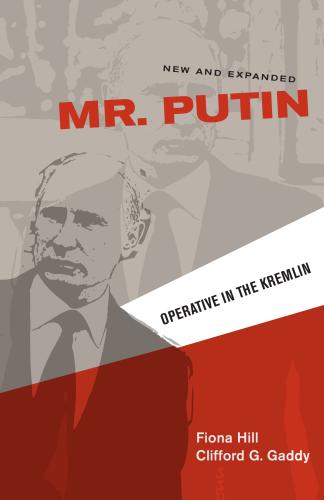
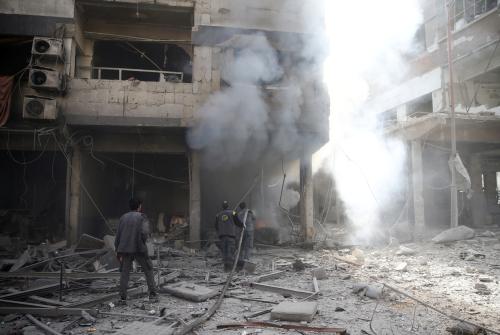
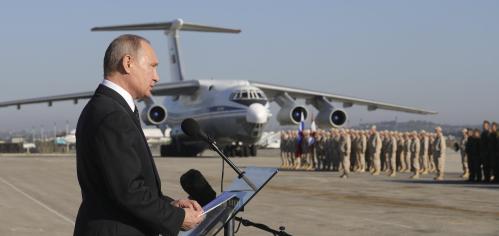

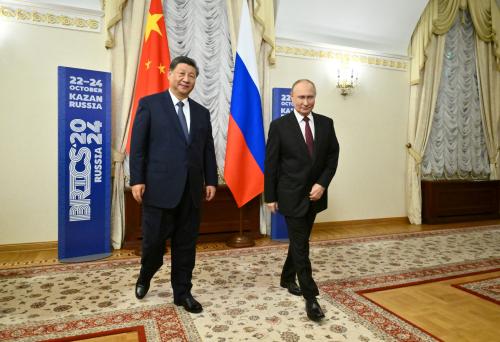

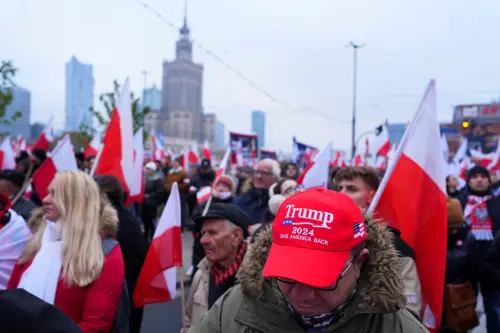
Commentary
What explains Russia’s uncharacteristic indifference to the revolution in Armenia?
May 7, 2018